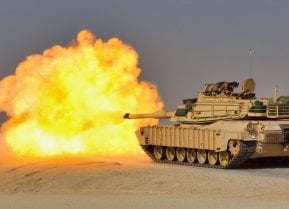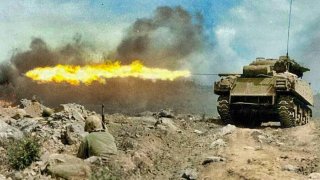Churchill Crocodile Was a Real Flamethrower Tank During World War II
The Churchill Crocodile tank was first produced in 1943. While it went on to serve in multiple battles, it undoubtedly made its biggest impact, both physically and psychologically, during the Normandy campaign.
Meet the Churchill VII Flamethrower Tank: Crocodiles are an apex predator. They are one of the deadliest reptiles on the planet, although statistically speaking the saw-scaled viper accounts for more human deaths. The saltwater crocodile in particular may have unintentionally played a small role in Imperial Japan's defeat during WWII. During the so-called Ramree Island Massacre of 1945, these aquatic beasts may have devoured up to 500 soldiers of the Imperial Japanese Army's 54th Division – though the story’s veracity is somewhat disputed.
Naturally, when one thinks of death by crocodile, one pictures a mauling, or perhaps being drowned. But then there came a mechanical crocodile that killed its victims by burning them to death: the Churchill VII "Crocodile" flamethrower tank.
Churchill VII Flamethrower Tank - Sir Winston's Fire-Breathing Namesake
Technically speaking, "Dragon" may have been a more accurate reptilian moniker for this tank than "Crocodile," but eh, why nitpick? Officially known as the Tank, Infantry, Mk IV (A22) Churchill Mark VII, it was part of a series that was named for the legend himself, British Prime Minister Winston Churchill, who had promoted the creation of the tank as a combat weapon during World War I.
The Churchill series was originally created as an infantry support tank. It was designed to navigate shell holes and trenches, plow through obstacles, and provide cover fire for foot soldiers. However, as a testament to the basic platform's versatility, the Churchill tanks were modified for a variety of specialized purposes, from troop and gun carriers to various sapper duties such as mine-clearing, bridge-laying, and vehicle recovery.
The Crocodile variant was pressed into service for cooking enemy soldiers alive. It carried a flamethrower in place of the usual hull-mounted BESA Mk 3 .303-caliber machine gun. In the process, the Crocodile became part of a group of customized tanks known as "Hobart's Funnies," named after Maj. Gen. Sir Percy Hobart. The flamethrower wielded by the Crocodile was the REME (as in Royal Electrical and Mechanical Engineers), which could project a stream of burning petrol at 4 gallons per second out to an effective range of 120 yards.
Churchill VII Flamethrower Tank - "Funny" to the Brits, Hellish to the Germans
The Crocodile tank was first produced in 1943. While it went on to serve in multiple battles, it undoubtedly made its biggest impact, both physically and psychologically, during the Normandy campaign. If the Tiger was the most feared German tank of WWII, then arguably the Crocodile was the most feared British tank.
Holger Eckhertz's renowned book D DAY Through German Eyes - The Hidden Story of June 6th 1944, includes this interview with Cornelius Tauber, then an Oberleutnant (First Lieutenant) with the Wehrmacht's 736th Infantry Regiment, 716th Infantry Division, posted at Juno Beach:
"After the war, I learned that ‘Crocodile’ was the official name for the thing. We came to know it as a Flammenpanzer (flame tank), and it had a hugely demoralising effect on our troops…Now, after that initial burst of flame, the Flammenpanzer began to fire at full power — and the effect was completely horrific. It produced a jet of fire, which was a burning liquid of orange-yellow colour…We all watched, stricken dumb by this apparition…The heat burned our skin and hair, and the smell of gasoline fuel was sickening…I think there was a dozen men in there, and they were set alight at once. I saw that the whole trench was filled with this burning liquid, and the men in there were incinerated where they stood. The heat was so intense that I couldn't breathe properly, as these flames were twenty metres away from me."
This member of the "Hobart's Funnies" club wasn't so damn funny to the Germans. It was downright horrific.
Where Are They Now?
The Crocodile continued to serve with the British Army – specifically with the 7th Royal Tank Regiment – during the early stages of the Korean War. It was withdrawn and retired in 1951. A number of these remarkable tanks survive today in museums around the globe, from the United Kingdom and United States as well as in Canada, Australia, and Russia. You can even find one in running order at the American Heritage Museum in Hudson, Massachusetts.
About the Author
Christian D. Orr is a former Air Force officer, Federal law enforcement officer, and private military contractor (with assignments worked in Iraq, the United Arab Emirates, Kosovo, Japan, Germany, and the Pentagon). Chris holds a B.A. in International Relations from the University of Southern California (USC) and an M.A. in Intelligence Studies (concentration in Terrorism Studies) from American Military University (AMU). He has also been published in The Daily Torch and The Journal of Intelligence and Cyber Security. Last but not least, he is a Companion of the Order of the Naval Order of the United States (NOUS).


